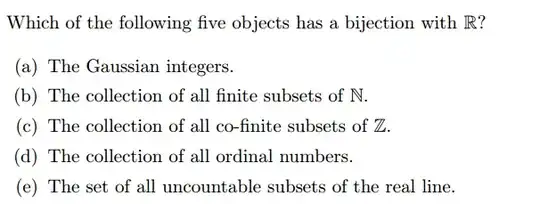I suppose the answer is E but not quite sure why because I only ruled out the first four. Any help would be appreciated!
-
1None of then has a bijection with $\mathbb R$. – Kavi Rama Murthy Oct 23 '19 at 12:15
-
@ Kabo Murphy could you please explain e? – scsnm Oct 23 '19 at 12:16
-
Note that e) is about the collection of all uncountable subsets of $\mathbb R$, not a particular uncountable subset of $\mathbb R$. – Kavi Rama Murthy Oct 23 '19 at 12:21
-
1In $e)$ , we clearly have an uncountable set. Each interval $[0,a]$ with a positive real number $a$ is uncountable. The question is whether the cadinality is even beyond that of $\mathbb R$ – Peter Oct 23 '19 at 12:21
-
@KaboMurphy The correct answer is (c). – José Carlos Santos Oct 23 '19 at 12:23
-
A rough handwavy proof of this... Recognize that the set of all subsets of $\Bbb R$ is equal to the union of the set of all uncountable subsets of the real line and the set of all countable subsets of the real line. See if you can argue why the one must be at least as large as the other, implying that if both were the same cardinality as $\Bbb R$ itself, they couldn't union to be something the cardinality of the power set of $\Bbb R$. – JMoravitz Oct 23 '19 at 12:23
-
1@JoséCarlosSantos that can't be the case. There is an obvious bijection between the set of cofinite subsets with the set of finite subsets. You can list finite subsets of $\Bbb N$ just as easily as you can list finite subsets of $\Bbb Z$. List all who have the maximum absolute value equal to $1$ (there are finitely many), followed by all who have maximum absolute value equal to $2$ (there are finitely many), and so on... – JMoravitz Oct 23 '19 at 12:25
-
1@JMoravitz Right! I was thinking about infinite subsets of $\mathbb Z$. – José Carlos Santos Oct 23 '19 at 12:26
-
@JMoravitz Is $e)$ a set with a cardinality beyond $\mathbb R$ ? How do we check this ? – Peter Oct 23 '19 at 12:28
-
1@Peter I am asking the same! HaHa – scsnm Oct 23 '19 at 12:29
-
1(# countable subsets of R) <= (# infinite sequence of reals) = (2 ^ aleph-0) ^ (aleph-0) = 2^(aleph-0 x aleph-0) = 2^(aleph-0). So (# uncountable subsets of R) must be bigger than (2^ aleph-0), since |power set of R| > (2^ aleph-0). Apologies for not knowing how to format this stuff. – Ned Oct 23 '19 at 13:01
-
@ Ned So there is no right answer then? – scsnm Oct 23 '19 at 13:08
2 Answers
The answer is not (e):
The set of all subsets of $\Bbb R$ is of cardinality strictly greater than $\Bbb R$.
The set of all countable subsets of $\Bbb R$ is the same cardinality as $\Bbb R$. See Cardinality of the set of at most countable subsets of the real line?
Reiterating the argument made there, invoking the axiom of choice we associate a sequence of real numbers to each countable subset. We have then $|\Bbb R^\Bbb N|=(2^{\aleph_0})^{\aleph_0}=2^{\aleph_0\cdot \aleph_0}=2^{\aleph_0}=|\Bbb R|$
From here, we recognize that the set of all subsets of $\Bbb R$ is equal to the union of the set of countable subsets and the set of uncountable subsets of $\Bbb R$.
It follows then that the set of uncountable subsets of $\Bbb R$ must be of cardinality strictly greater than $\Bbb R$.
The answer is not (c) either as there is an obvious bijection between the set of cofinite subsets with the set of finite subsets. You can list finite subsets of $\Bbb N$ just as easily as you can list finite subsets of $\Bbb Z$. List all who have the maximum absolute value equal to 1 (there are finitely many), followed by all who have maximum absolute value equal to 2 (there are finitely many), and so on... showing that (c) is countable.
(b) is countable by the same logic.
(a) is countable as there is a clear bijection with $\Bbb Z\times \Bbb Z$.
Finally as for (d), an ordinal is the set of all ordinals below it, so if the object described in (d) were a set and existed it would be the "biggest ordinal" and would clearly be greater in size than $\aleph_3$ and so bigger than the cardinality of the real numbers as well.
I am less familiar with these objects and suspect that the object described in (d) is not even a set in the first place but rather a proper class.
- 79,518
I think we can also show that e) is not the answer without the Axiom of Choice:
Let $\mathbb{R}_{\rm unc}$ be the set of all uncountable subsets of the reals. Also let $\mathcal{P}(S)$ be the power set of set $S$.
Starting with $\mathbb{R}\equiv (0,1)$ we can form a corresponding bijection $f:\mathcal{P}(\mathbb{R})\longrightarrow \mathcal{P}((0,1))$.
Now consider the map $g: \mathcal{P}(\mathbb{R})\longrightarrow \mathbb{R}_{\rm unc}$ given by $g(S) = f(S)\cup (1,2)$. This is an injective map since $f$ is injective.
Also the inclusion map $\iota: \mathbb{R}_\rm {unc}\longrightarrow \mathcal{P}(\mathbb{R})$ is an injection.
So by the Cantor-Schroeder-Bernstein Theorem, $ \mathbb{R}_\rm {unc}$ and $\mathcal{P}(\mathbb{R})$ have the same cardinality.
- 40,402
